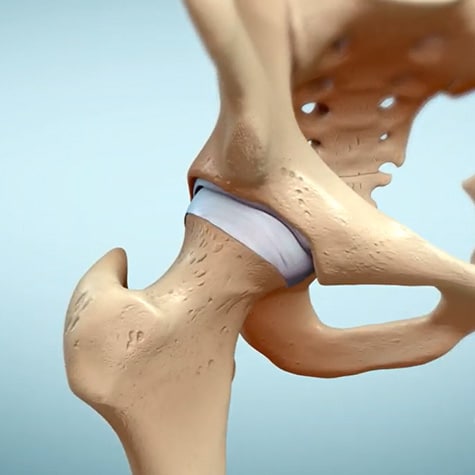Every patient is different, so our team of pediatric orthopedic specialists at Children’s Healthcare of Atlanta works closely with children and their families to determine the best treatment options available in treating a child’s hip condition. In some cases, our doctors may recommend a minimally invasive procedure called arthroscopic hip surgery. Our goal is to make this process as easy on patients and families as possible.
What conditions can be treated with hip arthroscopy?
Not every hip condition can be treated with an arthroscopic procedure. But advancements have made it an option for a growing list of hip conditions, including:
- Femoroacetabular impingement (FAI)
- Labral tears
- Loose bodies, or free-floating fragments of bone or cartilage
- Legg-Calve-Perthes disease
- Slipped capital femoral epiphysis (SCFE)
- Snapping hip syndrome
- Trauma- and sports-related injuries
During an arthroscopic hip surgery, the doctor puts a small camera and tools into the hip joint through several small openings. This allows a doctor to view the condition and repair it with tiny surgical instruments, likes shavers, drills and burs, without having to create a large incision along the child’s hip. The pain is mild, and most patients can go home the same day.

How do doctors perform arthroscopic hip surgery?
Learn how arthroscopic hip surgery is performed by our doctors.
Watch VideoRecovery time for arthroscopic hip surgery is shorter than that of open surgeries. Each procedure is different and may have a different set of guidelines for recovery. Immediately after surgery, patients can expect:
- Temporary tingling in their feet from the traction boots worn during surgery.
- To feel sick to their stomach or throw up because of anesthesia. Your child’s doctor can recommend medication to make your child feel less nauseous.
- Temporary swelling and numbness at the site of the surgery from a shot that helps with pain.
Following these directions can help heal the injury and ease pain:
- Change your child’s bandage after two days.
- Do not get your child’s incision wet until your child’s doctor says it is OK.
- Use a Game Ready sleeve if your doctor suggests it.
- Have your child wear a hip brace if your child’s doctor recommends it.
- Get sutures removed after two weeks.
- Do not have your child drive until your doctor clears your child to do so.
- Have your child do their best to not put a lot of weight on the injured leg by leaning on it. Your child can walk on it with crutches.
- Do not plant or turn on the injured leg.
- Your child should not point their toes outward. Keep them facing forward when lying down and on crutches.
- Do not bend over too far, such as when your child ties their shoes or picks something up off the floor.
- Use a continuous passive motion (CPM) machine according to your doctor’s instructions.
- Use ice to help relieve pain. You can also use pain medicine according to your doctor’s instructions.
What are the advantages of arthroscopic hip surgery?
The advantages of arthroscopic surgery over open surgery include:
- Less pain following the procedure
- Shorter recovery time
- Possibly an earlier return to school and other activities
- No overnight stay (in most cases)
Support on Facebook
Contact Us 404-255-1933

